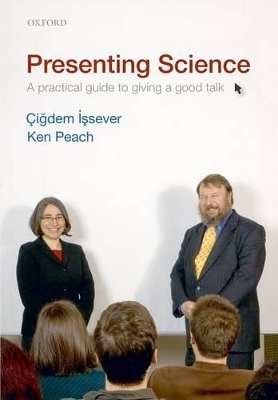
Presenting Science
Oxford University Press (Verlag)
978-0-19-954909-2 (ISBN)
'Giving a talk' is one of the most important ways in which we communicate our research. The 'talk' covers everything from a ten-minute briefing on progress to a handful of colleagues, to a keynote address to a major international conference with more than a thousand delegates. Whatever the occasion, the aim is the same - to get the message across clearly and effectively. At the same time, presentational skills are becoming more important in all walks of life - and presenting science has particular issues. Our aim is to equip the reader with the basic skills needed to make a good presentation, and our approach is pragmatic, not dogmatic. We emphasise four points:
- The goal is to communicate the science to the audience.
- The speaker is responsible for everything that appears, and does not appear, on each slide.
- The structure and appearance of the presentation are part of the communication process.
- There is no standard way of doing things.
Giving a good talk on science is a skill that can be learnt like any other: in this book we take the reader through the process of presenting science to a wide variety of audiences.
After completing her Ph.D in Dortmund, Germany, Cigdem Issever worked as a Post-doctoral researcher at University of California Santa Barbara, and as a Departmental Lecturer at the University of Oxford before being appointed University Research Lecturer in 2007 with the University of Oxford. After completing his Ph.D. in Edinburgh, Ken Peach worked as a University Demonstrator, Post-doctoral researcher, SERC Advanced Fellow and Research Officer at Edinburgh before being appointed Reader in 1992. In 1996 he was awarded a Personal Chair in Particle Physics Experiments, and moved to CERN as Deputy Leader of the Particle Physics Experiments Division, CERN. Two years later, he became Director of Particle Physics at the Rutherford Appleton Laboratory in Oxfordshire, and in 2004 also assumed responsibility as Director of e-Science. In 2005, he moved to the University of Oxford and Royal Holloway University of London, as Director of the John Adams Institute for Accelerator Science.
1. Introduction ; 2. Structure of the Presentation ; 3. Identifying the Context of the Presentation ; 4. Style ; 5. Preparation and Presentation ; 6. Concluding Remarks ; Appendix A: Presenting Complicated Equations - A Worked Example ; Appendix B: Some Powerpoint Tips ; Appendix C: Meeting the Media
| Erscheint lt. Verlag | 17.12.2009 |
|---|---|
| Zusatzinfo | 20 line figures, 16 colour plates |
| Verlagsort | Oxford |
| Sprache | englisch |
| Maße | 171 x 246 mm |
| Gewicht | 323 g |
| Themenwelt | Mathematik / Informatik ► Mathematik |
| Naturwissenschaften ► Biologie | |
| Naturwissenschaften ► Chemie | |
| Naturwissenschaften ► Physik / Astronomie ► Astronomie / Astrophysik | |
| ISBN-10 | 0-19-954909-5 / 0199549095 |
| ISBN-13 | 978-0-19-954909-2 / 9780199549092 |
| Zustand | Neuware |
| Haben Sie eine Frage zum Produkt? |
aus dem Bereich


